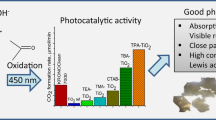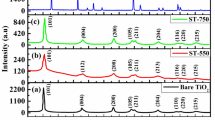Abstract
The influence of different modifiers, phosphorus, potassium, aluminium, and cerium on the pigmentary properties of TiO2 was studied. The phase composition and distribution of modifiers in prepared TiO2 products was investigated using XRD analysis, the selective leaching method, and ICP-AES technique. The optical properties, photoactivity, morphology, and surface area of modified TiO2 were determined by spectrophotometric, fluorescent, SEM, and BET measurements. The research was directed towards obtaining a pigmentary TiO2 with the highest possible photostability. It was found that the final calcination temperature, at which the anatase-rutile transformation rate was > 97 %, depended on the kind and amount of the modifiers introduced into hydrated titanium dioxide. In comparing the colour of TiO2 products modified with Ce, it was found that the addition of K to the TiO2 series caused an increase in all the optical properties examined. The presence of K and Al in TiO2 modified with Ce resulted in decreased photocatalytic activity. The photostability of TiO2 modified with Ce and K improved with an increase in P2O5 content. The highest photostability was measured for the TiO2-CePKAl series. It was concluded that the differences in both the optical properties and photoactivity of TiO2 depended on its phase composition and the distribution of modifiers in the products obtained.
Similar content being viewed by others
References
Allen, N. S., Edge, M., Ortega, A., Sandoval, G., Liauw, C. M., Verran, J., Stratton, J., & McIntyre, R. B. (2004). Degradation and stabilisation of polymers and coatings: nano versus pigmentary titania particles. Polymer Degradation and Stability, 85, 927–946. DOI: 10.1016/j.polymdegradstab.2003.09.024.
Bellussi, G., Bohnet, M., Bus, J., Drauz, K., Faulhammer, H., Greim, H., Jäckel, K. P., Karst, U., Klaffke, W., Kleemann, A., Laird, T., Meier, W., Mukherjee, J., Ottow, E., Qiao, G., Röper, M., Sundmacher, K., Ulber, R., van Dyk, B., von Heimburg, J., Wagemann, K., & Wietelmann, U. (2012). Ullman’s Encyclopedia of industrial chemistry. Weinheim, Germany: Wiley.
Braun, J. H., Baidins, A., & Marganski, R. E. (1992). TiO2 pigment technology: A review. Progress in Organic Coatings, 20, 105–138. DOI: 10.1016/0033-0655(92)80001-d.
Choi, W. Y., Termin, A., & Hoffmann, M. R. (1994). The role of metal ion dopants in quantum-sized TiO2: Correlation between photoreactivity and charge carrier recombination dynamics. The Journal of Physical Chemistry, 98, 13669–13679. DOI: 10.1021/j100102a038.
Colón, G., Sánchez-España, J. M., Hidalgo, M. C., & Navío, J. A. (2006). Effect of TiO2 acidic pre-treatment on the photocatalytic properties for phenol degradation. Journal of Photochemistry and Photobiology A: Chemistry, 179, 20–27. DOI: 10.1016/j.jphotochem.2005.07.007.
Dąbrowski, W., Tymejczyk, A., & Lubkowska, A. (2006). Właściwości i zastosowanie pigmentów dwutlenku tytanu (Properties and application of titanium dioxide pigments). Police, Poland: Chemical Plant “Police”.
Diebold, M. P. (1995). The causes and prevention of titanium dioxide induced photodegradation of paints. Part 1: Theoretical considerations and durability. Surface Coatings International, 78, 250–256.
Diebold, U. (2003). The surface science of titanium dioxide. Surface Science Reports, 48, 53–229. DOI: 10.1016/s0167-5729(02)00100-0.
Du, H. Y., Liu, C. X., Sun, J. Y., & Chen, Q. R. (2008). An investigation of angle-dependent optical properties of multilayer structure pigments formed by metal-oxide-coated mica. Powder Technology, 185, 291–296. DOI: 10.1016/j.powtec.2007.10.031.
Elsevier (2011). TiO2 buyers resist 2Q 2011 price hikes of $300–500 per tonne. Focus on Pigments, 2011, 3–5. DOI: 10.1016/s0969-6210(11)70065-0.
Fu, L. J., Liu, H., Zhang, H. P., Li, C., Zhang, T., Wu, Y. P., Holze, R., & Wu, H. Q. (2006). Synthesis and electrochemical performance of novel core/shell structured nanocomposites. Electrochemistry Communication, 8, 1–4. DOI: 10.1016/j.elecom.2005.10.006.
Gleń, M., Grzmil, B., Sreńscek-Nazzal, J., & Kic, B. (2011). Effect of CeO2 and Sb2O3 on the phase transformation and optical properties of photostable titanium dioxide. Chemical Papers, 65, 203–212. DOI: 10.2478/s11696-010-0103-x.
Gleń, M., & Grzmil, B. (2012). Photostability and optical properties of modified titanium dioxide. Pure and Applied Chemistry, 84, 2531–2547. DOI: 10.1351/pac-con-12-01-09.
Grzmil, B., Gleń, M., Kic, B., & Lubkowski, K. (2011). Preparation and characterization of single-modified TiO2 for pigmentary applications. Industrial & Engineering Chemistry Research, 50, 6535–6542. DOI: 10.1021/ie1016078.
Ishibashi, K., Fujishima, A., Watanabe, T., & Hashimoto, K. (2000). Detection of active oxidative species in TiO2 photocatalysis using the fluorescence technique. Electrochemistry Communucations, 2, 207–210. DOI: 10.1016/s1388-2481(00)00006-0.
Jesionowski, T., Siwińska-Stefańska, K., Krysztafkiewicz, A., Sójka-Ledakowicz, J., Koprowska, J., & Pęczkowska, B. (2007). Characterization of TiO2 surface following the modification with silane coupling agents. Polish Journal of Chemical Technology, 9, 72–76. DOI: 10.2478/v10026-007-0094-8.
Jung, K. Y., & Park, S. B. (2004). Photoactivity of SiO2/TiO2 and ZrO2/TiO2 mixed oxides prepared by sol-gel method. Materials Letters, 58, 2897–2900. DOI: 10.1016/j.matlet.2004.05.015.
Karvinen, S. M. (2003). The effects of trace element doping on the optical properties and photocatalytic activity of nanostructured titanium dioxide. Industrial & Engineering Chemistry Research, 42, 1035–1043. DOI: 10.1021/ie020358z.
Kolb, E. D., Grenier, J. C., & Laudise, R. A. (1981). Solubility and growth of AIPO4 in a hydrothermal solvent: HCl. Journal of Crystal Growth, 51, 178–182. DOI: 10.1016/0022-0248(81)90299-2.
Körösi, L., & Dékány, I. (2006). Preparation and investigation of structural and photocatalytic properties of phosphate modified titanium dioxide. Colloids and Surfaces A: Physicochemical and Engineering Aspects, 280, 146–154. DOI: 10.1016/j.colsurfa.2006.01.052.
Lewis, P. A. (1988). Pigment handbook. Properties and economics. Toronto, Canada: Wiley.
Li, L., Guo, W. L., Zhu, Y. S., & Wu, Y. P. (2011). Hydrogen production by photoelectrochemically splitting solutions of formic acid. ChemSusChem, 4, 1475–1480. DOI: 10.1002/cssc.201100167.
Onoda, H., & Sakumura, T. (2011). Synthesis, acid and base resistance of nickel-cerium (+III) phosphate pigments. Phosphorus Research Bulletin, 25, 50–55.
Rao, P. P., & Reddy, M. L. P. (2007). (TiO2)1(CeO2)1−x (RE2O3)x — novel environmental secure pigments. Dyes and Pigments, 73, 292–297. DOI: 10.1016/j.dyepig.2005.12.004.
Reidy, D. J., Holmes, J. D., & Morris, M. A. (2006). Preparation of a highly thermally stable titania anatase phase by addition of mixed zirconia and silica dopants. Ceramics International, 32, 235–239. DOI: 10.1016/j.ceramint.2005.02.009.
Tayade, R. J., Surolia, P. K., Kulkarni, R. G., & Jasra, R. V. (2007). Photocatalytic degradation of dyes and organic contaminants in water using nanocrystalline anatase and rutile TiO2. Science and Technology of Advanced Materials, 8, 455–462. DOI: 10.1016/j.stam.2007.05.006.
Tryba, B., Toyoda, M., Morawski, A. W., Nonaka, R., & Inagaki, M. (2007). Photocatalytic activity and OH radical formation on TiO2 in the relation to crystallinity. Applied Catalysis B: Environmental, 71, 163–168. DOI: 10.1016/j.apcatb.2005.12.036.
Woditsch, P., & Westerhaus, A. (1993). Titanium dioxide in industrial inorganic pigments. Weinheim, Germany: Wiley.
Wold, A. (1993). Photocatalytic properties of titanium dioxide (TiO2). Chemistry of Materials, 5, 280–283. DOI: 10.1021/cm00027a008.
Yu, J. C., Lin, J., & Kwok, R. W. M. (1998). Ti1−x ZrxO2 solid solutions for the photocatalytic degradation of acetone in air. The Journal of Physical Chemistry B, 102, 5094–5098. DOI: 10.1021/jp980332e.
Author information
Authors and Affiliations
Corresponding author
Rights and permissions
About this article
Cite this article
Gleń, M., Grzmil, B. Pigmentary properties of rutile TiO2 modified with cerium, phosphorus, potassium, and aluminium. Chem. Pap. 67, 1386–1395 (2013). https://doi.org/10.2478/s11696-013-0396-7
Received:
Revised:
Accepted:
Published:
Issue Date:
DOI: https://doi.org/10.2478/s11696-013-0396-7




